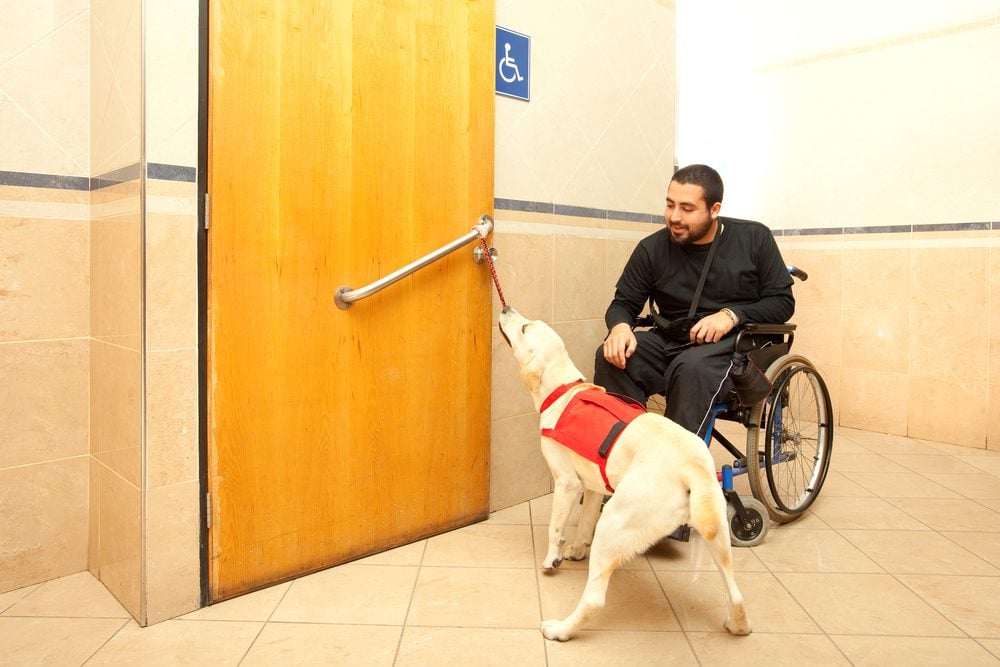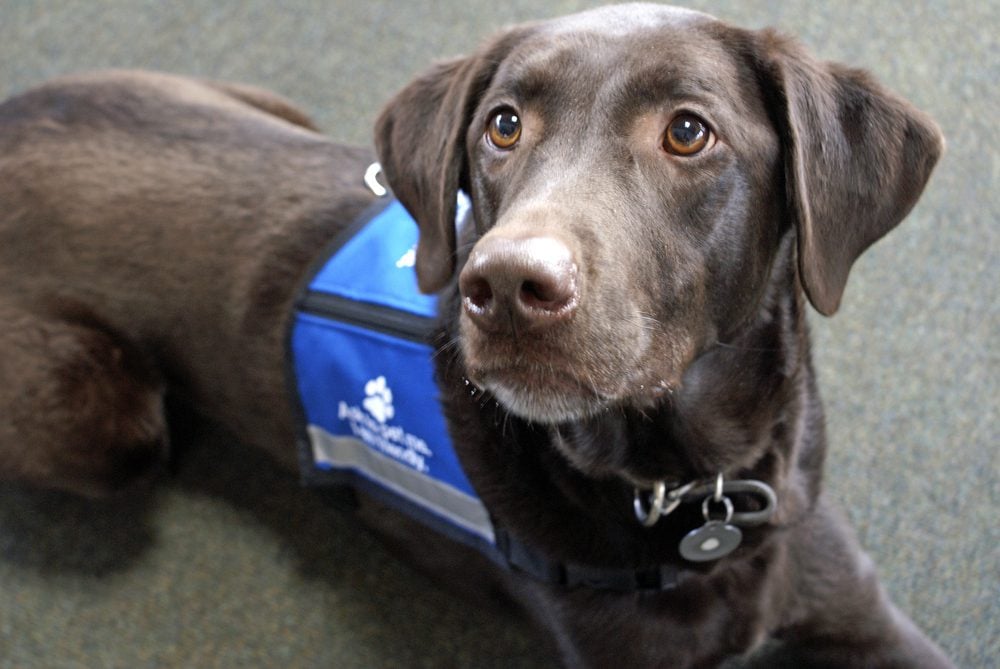Service dogs can offer life-changing assistance that makes it possible for those with disabilities to become more independent or participate in activities they otherwise couldn’t. Of course, service dogs are still animals and need care, so they may not be the best choice for everyone.
For those that are ready to gain a furry assistant, though, it can be difficult figuring out where to start. Where does one even get a service dog from? We’ll be answering that question, and many more, today. Keep reading to learn more about obtaining and affording a service dog.
What Is a Service Dog?
According to the Americans with Disabilities Act (ADA), a law that governs service dogs, a service dog is “a dog that is individually trained to do work or perform tasks for a person with a disability.” There are many different types of service dogs that are trained to help with a variety of disabilities.
Having a service dog can greatly improve someone’s quality of life because the dog may allow them to do things that they otherwise could not. Service dogs are some of the most highly trained dogs because not only must they be capable of performing tasks that go beyond simple tricks, but they must also be trained to go against their instincts.
Service dogs must be able to focus on their work and ignore the various stimuli around them. This means ignoring other people, animals, sights, sounds, and smells. Because service dogs are seen as vital to their handlers’ well-being, they are allowed in many places that other dogs are not.
Service dogs can join their handlers for free in the cabins of airplanes. They are also allowed in public places like department stores and restaurants. They can even go into hospitals and are allowed in any areas the public is allowed in.
Service dogs are also allowed to live with their handlers even in housing that does not allow pets, thanks to the Fair Housing Act (FHA). This is because service dogs are considered working animals and are seen as a necessity, unlike pets.
Service Dogs vs. Emotional Support Animals
Now that you understand exactly what a service dog is and some of their rights, let’s talk about emotional support animals (ESAs). Emotional support animals are very different from service dogs; in fact, they do not even have to be dogs, though dogs are a popular choice of ESA.
As their name suggests, ESAs provide emotional support to their owners via their presence. Many people find comfort in the companionship of an animal, and having an animal to pet or cuddle can help them cope with symptoms of mental health disorders such as anxiety or depression.
Emotional support animals do not have to undergo any intensive training at all; for dogs, their training can be akin to that which a companion dog would receive. However, because they are not highly trained and do not perform tasks for their owners, they are not allowed in public places or on airplanes as service dogs are.
Just like service dogs, ESAs are allowed to stay with their owners even in housing that doesn’t allow pets. This is because ESAs are also protected by the FHA and seen as a necessary treatment for the owner’s mental health disorder.
If your disability is of a mental nature and you do not need a dog to accompany you everywhere, then you may want to consider if an ESA would be a better option. Service dogs are incredibly expensive and can take years to get; meanwhile, an ESA could be a dog from a shelter that you can bring home within a week.
Where to Get a Service Dog



If you feel that a service dog is right for you, then you may be wondering how to get one. Though there are a few different options, you’ll want to start with talking to your doctor; if your doctor doesn’t agree that you need a service dog, it can be harder to obtain one.
Many organizations that provide fully trained service dogs (or offer training programs) will require evidence that you need a service dog. You may need something called a letter of medical necessity.
Once you’ve got that sorted, you can go about searching for a service dog. Here are the options available to you.
Non-Profit Organization or Charity
There are many non-profit organizations that aim to provide service animals for those with disabilities. Some, but not all, charities are able to give service dogs away for free. Those that can’t will instead offer service dogs to those in need at a reduced price.
Charities that do have the fundraising available to provide dogs for free usually have long waiting lists. It can take between one and five years to receive a dog, which may not be realistic for some.
Other charities that require partial payment from those seeking a service dog may have shorter waitlists. However, partial payments can still be quite expensive, sometimes costing even $10,000. Of course, this is still cheaper than the total cost of the dog, which is often upwards of $20,000. Some of the most expensive service dogs can cost $50,000.
Although it can be expensive to get a fully trained service dog from a non-profit organization, it’s often worth it. These organizations make sure the dogs have good temperaments and are fully vetted. They also ensure that the recipient is prepared to receive their dog.
This doesn’t just mean providing a list of supplies. Rather, the recipient of the service dog is usually given classes on how to handle the dog. They’re taught the dog’s many commands as well as the general training style used. This also gives the dog a chance to get acquainted with and begin to bond with their soon-to-be owner.
Service Dog Trainer
Another option is to get a dog trained by a professional trainer or training organization that specializes in service dog training. In this situation, you would normally provide the dog, who would then be boarded and trained at the trainer’s facility.
If you don’t have a dog but are still interested in this kind of service, many trainers are willing to help you pick out a puppy. Some even partner with breeders for this purpose. Because not all dogs are suited to becoming service dogs, there is a bit of financial risk involved.
You may buy a dog and pay for training only for it to be deemed unfit for service work. However, the trainers can help you pick out a puppy that has promising qualities.
If you already have a dog, then the trainers will usually evaluate them to determine if they may be fit for service work. Once again, even if the dog is accepted into a training program, there is no guarantee that they will be able to complete it.
Because of this, this route may be best for someone who doesn’t necessarily need a dog in public places. Dogs may be unable to complete training if they have confidence or fear issues, but that doesn’t always mean that their training is completely useless.
Sometimes, they can still be helpful in one’s home by reminding their handler to take medications or by fetching objects. The skills they learn may not be reliable in public if the dog is overwhelmed in bustling areas, but that doesn’t mean the dog can’t still be of assistance when at home.
Another nice thing about having a dog trained is that the dogs are usually ready within about six months. You can get a dog much sooner than you would if you were to try and get a fully trained dog from a charitable organization that has to put you on a waiting list.
Just be sure that you have a plan in case your dog ends up being unsuited for service work. Will you be able to keep the dog, and if not, do you know someone who is willing to give it a loving home?
If you feel like this could be the best option for you to get a service dog, then be sure to look carefully at the different trainers or organizations offering service dog training. You should ask them what kind of training techniques they use as well as look up reviews. You want to be sure that your dog is trained with respectful techniques that do not involve physical punishment or pain of any sort.
Train a Dog Yourself
There is nothing in the ADA that states you cannot train your own dog. In fact, you are completely within your rights to do so. If you are not experienced with dog training, then this may not be easy for you, but training your own dog will help you save money and ensure the dog is tailored exactly to your needs.
Of course, you don’t have to do it all by yourself. You can hire a professional trainer to help you. This is different from our previous option because the dog will not be boarded with the trainer, and you will be doing most of the work. Instead, the trainer will teach you how to teach your dog the skills that will help your disability.
As expected, there will be a cost to hire a trainer. Though it will be more affordable than purchasing a fully trained service dog, it can still get expensive. Other training options include online training packages, which tend to be more affordable.
There are various organizations offering online training, and some are even live over webcam so you can talk one-on-one with a trainer. While they’re more affordable, you’ll miss out on the environment of an in-person class, which often offers distractions in the form of other dogs and other people. Instead, you’ll be responsible for exposing your dog to such stimuli.
Here at USSA, we offer an affordable online service dog training course for Psychiatric Service Dogs (PSDs). If a PSD is the type of service dog you need, then our online training course may be perfect for you.
How to Afford a Service Dog



Oftentimes, the main factor keeping people from getting a service dog is the cost. Service dogs are not cheap, and charities don’t have the resources to help every single person in need. So, how do you afford a service dog? We’ll discuss the different options for paying for one of these life-changing dogs.
Why Are Service Dogs So Expensive?
Before we talk about how to afford a service dog, let’s talk about why they are so expensive. So how much do they cost? It often depends on where you get the dog from as well as what the dog is trained to do. However, you can generally expect a service dog to cost anywhere between $10,000 and $50,000.
Service dogs undergo training for up to two years. During that time, they require food, housing, and veterinary care just like any other dog. On top of that, the dogs’ trainers need to get paid for their time.
This is why service dogs are so expensive and can cost up to $50,000. Not only do their basic needs need to be met, but there is also a lot of work put into their training. Some dogs are unable to complete their training, which is another factor in the expensive price tag of a successful service dog.
The price must also cover the investment lost in other dogs because, unfortunately, it’s impossible to know for sure which dogs will excel and which won’t. Whenever an organization trains dogs, there will almost always be some that pass and some that don’t.
Now that you have a sense of why these dogs cost so much, let’s talk about the different options you have for affording one.
Online Training
One of the best options for obtaining a service dog affordably is training your dog yourself through online training courses. These courses are typically put together by professional trainers who record instructional videos, write detailed content and exams, and are often available to answer any questions you have. Because you’re not working one-on-one with a trainer for hours over the course of several weeks (or even months or years) the cost is significantly lower – sometimes as little as a few hundred dollars versus tens of thousands.
Of course, this amount can still be challenging to obtain on some budgets; however, the following options can be helpful when trying to raise the funds to pay for online courses instead of obtaining a fully trained service dog – and it can be much easier to meet your financial goal when it’s this much smaller.
Insurance
Many people wonder if their health insurance will cover (at least some of) the cost of a service dog. Unfortunately, the answer is usually no.
However, if you have a flexible spending account (FSA) attached to your insurance policy, then you may be able to use it for a service animal. In order to do so, you will first need a letter of medical necessity from your doctor.
Grants
There are a number of non-profit organizations that offer grants to people with disabilities to help them afford the cost of a service dog. Grants, unlike loans, do not have to be paid back. Depending on the organization, the grant may not cover the entire price of the dog, but it can still help offset the cost.
Fundraising
Many people who need service dogs turn to fundraising. These days, there are many options for fundraising, and you may be able to reach a wider audience via websites like GoFundMe. Don’t be afraid to ask friends and family for help, even if that help is simply sharing your story and the link to your fundraiser.
Another option is to ask churches, local businesses, or other community organizations if they’d be willing to help you fundraise. Sometimes, businesses will agree to put a percentage of their earnings for a day toward your cause. Churches can ask for donations on your behalf.
Personal Loans
If you’re certain a service dog is the best option for you but don’t have the means to afford one, you could consider taking out a personal loan. Of course, you will have to pay back the loan and any interest it accrues, which can be quite a bit considering how much service dogs cost. However, if you’re able to earn some money from fundraising or grants, you may not have to take out as large of a loan.
Service Dogs Are Life-Changing



Though they may be expensive or take years to obtain, service dogs can provide life-changing support to their handlers. They often make it possible for people to do things they otherwise could not do. Service dogs can even allow their handlers to lead more independent lives.
While non-profit organizations are often the first place people look to get a service dog, you can also get a dog trained by a professional or even train one yourself. These options are usually more affordable than getting a fully trained dog that is ready to go, though they aren’t without risk.
If you’d rather get a fully trained dog, affording it isn’t always easy. Your best bet is to search for grants, hold fundraisers, or consider taking out a personal loan.
However you decide to go about getting a service dog, you will gain a four-legged assistant whose help is indispensable. Not only that, they’ll be a great friend and companion both in and out of their harness.
